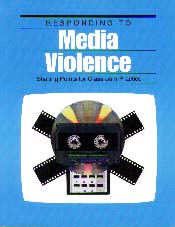|
________________
CM . . . .
Volume V Number 9 . . . . January 1, 1999
excerpt: A media literate person has an informed and critical understanding of the nature, technique and impact of mass media, as well as the ability to construct media texts for a variety of purposes. Key concepts and skills of media literacy are most effectively acquired through activities that balance the dual importance of understanding and producing media texts.Responding to Media Violence offers the elementary/junior high school educator a concise package of facts, theories and practices surrounding the teaching of media literacy in general and media violence in particular. With new curricula, such as the Western Canadian Protocol for English Language Arts, calling for the integration of viewing and representing into language arts classroom, teachers are hungry for informative and practical materials. I am happy to recommend this book. Responding to Media Violence is Canadian. The book is organized into background information and teaching ideas for four units of media violence study: fantasy media, real life media, news media and sports media. All teaching materials, including suggestions for activities and assessment, are organized by grade: kindergarten, grades 1-3 and grades 4-8. It features fascinating facts, such as the probably not surprising news that the most popular video games are those centered on fantasy violence themes, and that premium cable channels feature 85% violent programming. It also offers theories (called 'Informing Practice') such as basic concepts of media literacy beginning with "Media are constructions of reality." Of perhaps most immediate interest to teachers are copyright free blackline masters including collection sheets for surveys and letters to parents to introduce units in media violence. The letters are a wise precaution, though I found the contents and suggestions for parent/child involvement more appropriate for parents of younger students than for those in Grades 7 and 8. Responding to Media Violence ends with suggestions for conducting discussions on sensitive issues such as violence in the school or neighborhood, or dealing with students who are refugees from countries where violence is extreme. I will certainly use Responding to Media Violence with students and teachers as a way to increase critical viewing and to foster creative representation of media constructions. It is a worthy addition to any professional library. Highly recommended. Deborah L. Begoray is an assistant professor in Reading/Language Arts in the Faculty of Education at the University of Manitoba. She is currently researching viewing and representing across the curriculum at a grade 5 - 8 school.
To comment on this title or this review, send mail to cm@umanitoba.ca.
Copyright © the Manitoba Library Association.
Reproduction for personal use is permitted only if this copyright notice
is maintained. Any other reproduction is prohibited without
permission.
Published by
TABLE OF CONTENTS FOR THIS ISSUE - JANAURY 1, 1999.
AUTHORS |
TITLES |
MEDIA REVIEWS |
PROFILES |
BACK ISSUES |
SEARCH |
CMARCHIVE |
HOME
|

